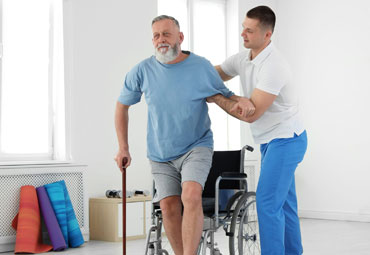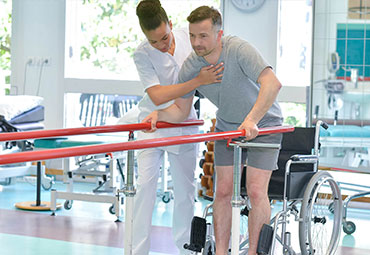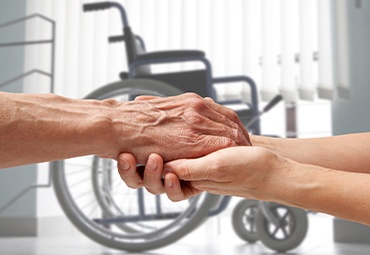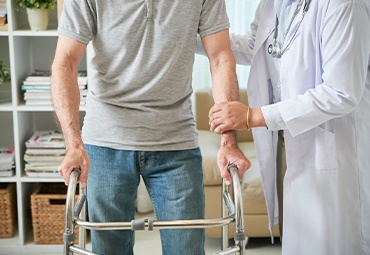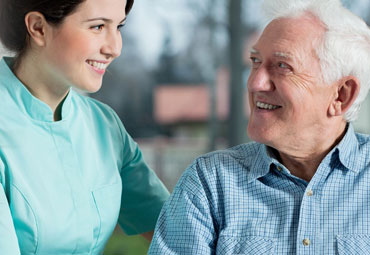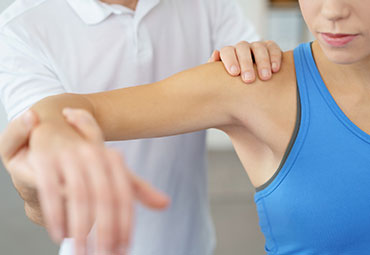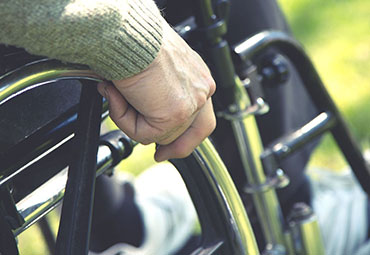
Stroke is one of the leading causes of death and disability in India finds research. Time is of essence when someone has a stroke meaning having a set of symptoms associated with stroke. Treatment is most effective when given soon after a stroke begins. Stroke Rehabilitation experts from ReAble share about Stroke and what you need to know in this article.
What is a stroke | Stroke types | Symptoms of stroke | Causes of stroke | Risk Factors | Brain Stroke Treatment
What is a stroke?
American Stroke Organisation says that a stroke occurs when a blood vessel that carries oxygen and nutrients to the brain is either blocked by a clot or bursts (or ruptures). When that happens, part of the brain cannot get the blood (and oxygen) it needs, so it and brain cells die.
Brain damage has an effect on how the body works. It can also change how you think and feel. The effects of a stroke depend on where it takes place in the brain, and how big the damaged area is. ReAble client Mrs Akshata Patel remarks, “My uncle had stroke 2 years ago, due to which his left side of body was paralyzed.”
A stroke is also called a cerebrovascular accident, CVA, or “brain attack.”
People at risk for stroke include those who have high blood pressure, high cholesterol, diabetes, and those who smoke. People with heart rhythm disturbances, especially atrial fibrillation are also at risk.
What are the types of stroke?
Based on what is causing it, stroke can be classified into three different types. They are ischaemic strokes, haemorrhagic strokes and transient ischemic attacks.
- An ischaemic stroke is caused by an artery in the brain being obstructed or blocked, preventing oxygen-rich blood from being delivered to brain cells.
- A Haemorrhagic stroke is caused by a bleeding in or around the brain. When a blood vessel leaks and spills blood into brain tissue, those brain cells stop working. The bleeding or hemorrhage is often due to poorly controlled high blood pressure that weakens the wall of an artery over time.
- A transient ischaemic attack or TIA is also known as a mini-stroke. It is the same as a stroke, except that it is a short-lived stroke that gets better and resolves spontaneously. It is a short-lived episode (less than 24 hours) of temporary impairment of brain function that is caused by a loss of blood supply. A TIA causes a loss of function in the area of the body that is controlled by the portion of the brain affected.
Symptoms of Stroke
The main stroke signs and symptoms include:
- Face Drooping – the face may have dropped on 1 side, the person may not be able to smile, or their mouth or eye may have drooped.
- Muscle Numbness – the person may not be able to lift both arms and keep them there because of weakness or numbness in 1 arm. The person may stumble, lose balance or have trouble walking.
- Trouble with Speech – their speech may be slurred or garbled, or the person may not be able to talk at all despite appearing to be awake; they may also have problems understanding what you’re saying to them.
- Vision problems– the person may have a sudden blurred or blackened vision in one or both eyes.
- Headache – they may experience sudden severe headache, accompanied with nausea and vomiting.
It is important for everyone to be aware of stroke signs and symptoms, as it can affect anyone anywhere. From the onset of symptoms, there is only a 3 to 4 1/2 hour window to use clot-busting drugs (thrombolytics) to try to restore blood supply to the affected part of the brain. The sooner one recognises that Stroke has begun, the sooner they can seek medical help and better the chances of their recovery.
Causes of Stroke
There are two main causes of stroke:
- A blocked artery (ischemic stroke) or
- Leaking or bursting of a blood vessel (hemorrhagic stroke)
As we age, our arteries become harder and narrower and more likely to become blocked. However, certain medical conditions and lifestyle factors can speed up this process and increase your risk of having a stroke.
Risk factors associated with Stroke
Many factors can increase your stroke risk. Some risk factors for stroke can be changed or managed, while others can’t.
Controllable Risk Factors of Stroke
Risk factors for stroke that can be changed, treated, or medically managed:
- High blood pressure. Blood pressure of 140/90 or higher can damage blood vessels (arteries) that supply blood to the brain.
- Heart disease. Heart disease is the second most important risk factor for stroke, and the major cause of death among survivors of stroke.
- People with diabetes are at greater risk for a stroke than someone without diabetes.
- Smoking almost doubles your risk for an ischemic stroke.
- Birth control pills (oral contraceptives)
- History of TIAs (transient ischemic attacks). If you have had one or more TIAs, you are almost 10 times more likely to have a stroke than someone of the same age and sex who has not had a TIA.
- High red blood cell count. A significant increase in the number of red blood cells thickens the blood and makes clots more likely. This raises the risk for stroke.
- High blood cholesterol and lipids. High cholesterol levels can contribute to thickening or hardening of the arteries (atherosclerosis) caused by a buildup of plaque, decreasing the amount of blood flow to the brain.
- Lack of exercise and Obesity
- Excessive alcohol and illegal drug use
Uncontrollable Risk Factors of Stroke
Risk factors for stroke that can’t be changed:
- Older age increases the chance of having a stroke
- African Americans have a much higher risk for death and disability from a stroke than whites
- Stroke occurs more often in men, but more women than men die from stroke.
- History of prior stroke
- Heredity or genetics. The chance of stroke is greater in people with a family history of stroke.
Brain Stroke Treatment
In case of Stroke, treatment is most effective when started right away. Advanced medical and surgical treatments, acute stroke interventions, along with recovery and rehabilitation treatments, are available that can help you recover from the effects of stroke. Therapies aim to maximize function in brain areas that survive the stroke, or provide compensatory approaches to improve overall function [2].
Brain Stroke Treatment progresses in 3 phases:
- Acute Care – A stroke is a medical emergency. Acute phase of treatment includes emergency treatment and stabilising the medical condition of the patient in an ICU or hospital setting.
- IPD Rehabilitation – Physiotherapist begin working with stroke patients to improve breathing, eye function (if involved), lung function, limb movement, getting up and changing position in bed, overall mobility and basic functions of toileting etc depending upon the severity of stroke.
- Stroke Rehabilitation–Once discharged from hospital, the rehabilitation continues at home (or at a rehabilitation centre). The purpose of stroke rehabilitation is to return the stroke patient to the life and level of function that existed before the stroke. The success of that goal depends upon the underlying health of the patient and severity of the stroke.
Rehabilitation may take weeks or months. ReAble client Mrs Akshata Patel continues, “My uncle had stroke 2 years ago, due to which his left side of body was paralyzed.We had shown him to number of doctors, tried Ayurveda and all sort of treatment.” She continues, “Final resort we went for ReLiva’s Neuro Rehabilitation for him. It’s been a month since we started treatment with ReAble and we are seeing significant improvement in his condition.”
ReAble uses a team approach for success; with a team of specialists including physiotherapists, occupational therapists, speech pathologists and rehabilitation specialists. An expert neuro physiotherapist will take a detailed assessment to understand the current condition and impairments of the stroke patient. A customised stroke rehabilitation plan will be designed based on the patient status and part of their body or type of ability affected by the stroke. Call us now or connect with us by filling the form below and we will be happy to help!
Stroke? Ask for Call Back
Scientific References:
[1] Stroke Epidemiology and Stroke Care Services in India; Jeyaraj Durai Pandian corresponding authora and Paulin Sudhanb; Published online 2013 Sep 27. doi: 10.5853/jos.2013.15.3.128
[2] Stroke Recovery & Rehabilitation Research: Issues, Opportunities, and the NIH Stroke Net; Stroke. Author manuscript; available in PMC 2018 Mar 1.Published in final edited form as: Stroke. 2017 Mar; 48(3): 813–819.Published online 2017 Feb 7. doi: 10.1161/STROKEAHA.116.015501
All content provided on this blog is for informational purposes only and is not intended to be a substitute for professional medical advice, diagnosis, or treatment. Always seek the advice of a qualified medical practitioner with any questions you may have regarding a medical condition.
- Date:11 Aug, 2021
- Posted By:ReAble
- Categories:Stroke
- Tags: brain stroke, causes of stroke, CVA, stroke types, symptoms of stroke






